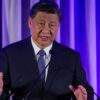Technology
China’s racing to create its AI ecosystem as U.S. tech curbs chunk. Right here’s how its provide chain stacks up
Chip engineer dealing with a wafer. In comparison to Nvidia’s export-restricted chips, the efficiency hole between Huawei and the H20 is lower than a complete age,” said Dylan Patel, founder, CEO and chief analyst of SemiAnalysis.
Sinology | Moment | Getty Images
With the U.S. restricting China from buying advanced semiconductors used in artificial intelligence development, Beijing is placing hopes on domestic alternatives such as Huawei.
The task has been made more challenging by the fact that U.S. curbs not only inhibit China’s access to the world’s most advanced chips, but also restrict availing technology vital for creating an AI chip ecosystem.
Those constraints span the entire semiconductor value chain, ranging from design and manufacturing equipment used to produce AI chips to supporting elements such as memory chips.
Beijing has mobilized tens of billions of dollars to try to fill those gaps, but while it has been able to “brute pressure” its way into some breakthroughs, it still has a long way to go, according to experts.
“U.S. export controls on complicated Nvidia AI chips have incentivized China’s business to manufacture choices, past additionally making it harder for home corporations to take action,” said Paul Triolo, partner and senior vice president for China at advisory firm DGA-Albright Stonebridge Group.
Here’s how China stacks up against the rest of the world in four key segments needed to build AI chips.
AI chip design
Nvidia is thought of as the arena’s well-known AI chip corporate, however it’s impressive to keep in mind that it doesn’t if truth be told form the bodily chips which might be old for AI coaching and computing.
In lieu, the corporate designs AI chips, or extra exactly, graphics processing devices. Orders of the corporate’s patented GPU designs are after despatched to chip foundries — producers focusing on the collection manufacturing of alternative firms’ semiconductor merchandise.
Hour American competition reminiscent of AMD and Broadcom do business in various choices, GPU designs from Nvidia are well known because the business same old. The call for for Nvidia chips is so sturdy that Chinese language shoppers have persevered to shop for any of the corporate’s chips they are able to get their palms on.
However Nvidia is grappling with Washington’s tightening restrictions. The corporate noticeable in April that additional curbs had prevented it from selling its H20 processor to Chinese clients.
Nvidia’s H20 was a less sophisticated version of its H100 processor, designed specifically to skirt previous export controls. Nevertheless, experts say, it was still more advanced than anything available domestically. But China hopes to change that.
In response to restrictions, more Chinese semiconductor players have been entering the AI processor arena. They’ve included a wide array of upstarts, such as Enflame Technology and Biren Technology, seeking to soak up billions of dollars in GPU demand left by Nvidia.
But no Chinese firm appears closer to providing a true alternative to Nvidia than Huawei’s chip design arm, HiSilicon.
Huawei’s most advanced GPU in mass production is its Ascend 910B. The next-generation Ascend 910C was reportedly anticipated to start out collection shipments as early as Would possibly, regardless that incorrect updates have emerged.
Dylan Patel, founder, CEO and important analyst at SemiAnalysis, instructed CNBC that past the Ascend chips stay in the back of Nvidia, they display that Huawei has been making important advance.
“In comparison to Nvidia’s export-restricted chips, the efficiency hole between Huawei and the H20 is lower than a complete age. Huawei isn’t some distance in the back of the goods Nvidia is authorized to promote into China,” Patel said.
He added that the 910B was two years behind Nvidia as of last year, while the Ascend 910C is only a year behind.
But while that suggests China’s GPU design capabilities have made great strides, design is just one aspect that stands in the way of creating a competitive AI chip ecosystem.
AI chip fabrication
To manufacture its GPUs, Nvidia relies on TSMC, the world’s largest contract chip foundry, which produces most of the world’s advanced chips.
TSMC complies with U.S. chip controls and is also barred from taking any chip orders from companies on the U.S. trade blacklist. Huawei was placed on the list in 2019.
That has led to Chinese chip designers like Huawei to enlist local chip foundries, the largest of which is SMIC.
SMIC is far behind TSMC — it’s officially known to be able to produce 7-nanometer chips, requiring less advance tech than TSMC’s 3-nanometer production. Smaller nanometer sizes lead to greater chip processing power and efficiency.
There are signs that SMIC has made progress. The company is suspected to have been behind a 5-nanometer 5G chip for Huawei’s Mate 60 Pro, which had rocked confidence in U.S. chip controls in 2023. The company, however, has a long way to go before it can mass-produce advanced GPUs in a cost-efficient manner.
According to independent chip and technology analyst Ray Wang, SMIC’s known operation capacity is dwarfed by TSMC’s.
“Huawei is an excellent chip design corporate, however they’re nonetheless with out excellent home chipmakers,” Wang said, noting that Huawei is reportedly working on its own fabrication capabilities.
But the lack of key manufacturing equipment stands in the way of both companies.
Advanced Chip equipment
SMIC’s ability to fulfill Huawei’s GPU requirements is limited by the familiar problem of export controls, but in this case, from the Netherlands.
While Netherlands may not have any prominent semiconductor designers or manufacturers, it’s home to ASML, the world’s leading supplier of advanced chipmaking equipment — machines that use light or electron beams to transfer complex patterns onto silicon wafers, forming the basis of microchips.
In accordance with U.S. export controls, the country has agreed to block the sale of ASML’s most advanced ultraviolet (EUV) lithography machines. The tools are critical to making advanced GPUs at scale and cost-effectively.
EUV is the most significant barrier for Chinese advanced chip production, according to Jeff Koch, an analyst at SemiAnalysis. “They have most of the other tooling available, but lithography is limiting their ability to scale towards 3nm and below process nodes,” he told CNBC.
SMIC has found methods to work around lithography restrictions the usage of ASML’s much less complicated deep ultraviolet lithography methods, that have perceptible relatively fewer restrictions.
Via this “brute forcing,” producing chips at 7 nm is doable, but the yields are not good, and the strategy is likely reaching its limit, Koch said, adding that “at stream surrenders it seems that SMIC can’t assemble plenty home accelerators to satisfy call for.”
SiCarrier Technologies, a Chinese company working on lithography technology, has reportedly been linked to Huawei.
But imitating existing lithography tools could take years, if not decades, to achieve, Koch said. Instead, China is likely to pursue other technologies and different lithography techniques to push innovation rather than imitation, he added.
AI memory components
While GPUs are often identified as the most critical components in AI computing, they’re far from the only ones. In order to operate AI training and computing, GPUs must work alongside memory chips, which are able to store data within a broader “chipset.”
In AI applications, a specific type of memory known as HBM has become the industry standard. South Korea’s SK Hynix has taken the industry lead in HBM. Other companies in the field include Samsung and U.S.-based Micron.
“High bandwidth memory at this stage of AI progression has become essential for training and running AI models,” said analyst Wang.
As with the Netherlands, South Korea is cooperating with U.S.-led chip restrictions and began complying with fresh curbs at the sale of positive HBM reminiscence chips to China in December.
In reaction, Chinese language reminiscence chip maker ChangXin Reminiscence Applied sciences, or CXMT, in partnership with chip-packaging and checking out corporate Tongfu Microelectronics, is within the early phases of manufacturing HBM, consistent with a report by Reuters.
Consistent with Wang, CXMT is anticipated to be 3 to 4 years in the back of world leaders in HBM building, regardless that it faces primary roadblocks, together with export controls on chipmaking apparatus.
SemiAnalysis estimated in April that CXMT remained a occasion clear of ramping any affordable quantity.
Chinese language foundry Wuhan Xinxin Semiconductor Production is reportedly development a manufacturing facility to assemble HBM wafers. A report from SCMP mentioned that Huawei Applied sciences had partnered with the company in generating HBM chips, even supposing the firms didn’t verify the partnership.
Huawei has inclined on HBM stockpiles from providers like Samsung for utility of their Ascend 910C AI processor, SemiAnalysis mentioned in an April report, noting that past the chip used to be designed regionally, it nonetheless is determined by overseas merchandise acquired previous to or regardless of restrictions.
“Whether it be HBM from Samsung, wafers from TSMC, or equipment from America, Netherlands, and Japan, there is a big reliance on foreign industry,” SemiAnalysis mentioned.





